User:Dsteele77/sandbox
Tourism in Sri Lanka is growing rapidly. For centuries, Sri Lanka has been a popular place of attraction for foreign travelers. The Chinese traveler Fa-Hien visited Sri Lanka as early as the 4th century, and in the twelfth century, Italian explorer Marco Polo claimed Sri Lanka to be the "best island of its size in the world".

Location
[edit]Sri Lanka is an island country located in the Indian Ocean. It belongs the continent of Asia, but does not share land borders with any nation. The approximate size of Sri Lanka is 65,610 square kilometers.[1]
Background
[edit]Land and Climate
[edit]Sri Lanka is considered to have a tropical climate. The average temperature ranges from 28-32 degrees Celsius, depending on elevation, but temperatures in the region surrounding Nuwara Eliya can fall to 16 degrees Celsius during winter months. Monsoon-style rain can be expected at any time during the year, however the least amount of rain is likely to occur during the months of December and January, which are also considered the coldest months.
Most of the Island is flat, with the exception of the south-central highlands, where you can find a variety of landforms including peaks, valleys, basins, etc.[2]
History
[edit]
Inhabitants are said to have existed on the island more than 28,000 years ago, with peoples and language fragments still existing from those ancestors. Around 300 BCE a trading establishment dominated the island, followed by an impressive irrigation system that was completed around 100 CE, and by 500 CE, several million people lived on the island. Various settlements existed between 500 CE and 1505 CE, when the Portuguese
arrived and began conducting affairs on the island. Over the next several hundred years the control of Sri Lanka passed to the Dutch, then to the British. In 1946, self-government was achieved with the creation of a new bicameral legislature and constitution, which was changed almost completely in 1972 and again in 1978. About 5 years later, a civil war broke out that lasted to some degree until the government gained control in 2009, when the war was declared over.[3]
The People
[edit]Population
[edit]As of 2018, the population is 20,933,914, of which 19% live in Urban areas, with the median age being 32.7 years old. The population growth rate in Sri Lanka was about 2% per year in the mid 20th century but has steadily declined to a current growth rate of .35%.[4]
Government
[edit]The constitution of Sri Lanka designates the government as a democratic republic with an executive presidency. The president, currently HE Maithripala Sirisena, is the head of the state and government. There is also a parliament with 225 members who are directly elected from various regions. The president and members of parliament are elected every 6 years.[5] Sri Lanka is also a member of The Commonwealth.
Economy
[edit]Sri Lanka is classified as an emerging economy, with the service sector making up the majority of GDP, followed by industry. Some of the main industries on the island are:
- rubber processing
- tourism
- shipping
- textiles
- cement
- petroleum refining
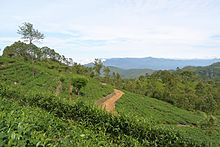
Agriculture plays an important yet small role in the economy, bringing in about 8% of the GDP. Some of the main agricultural products include:
- rubber
- tea
- rice
- sugarcane
- milk
- grain
- spices
- fruit
Language
[edit]There are two official languages on the Island, Sinhalese and Tamil. Sinhalese is spoken by 100% of the population (75% as a first language, 25% as a second language), while Tamil is spoken by 25% of the population. English is not an official language, and can only be spoken fluently by about 10% of the population.[6]
Religion
[edit]
Religion plays a large role in the culture and society of Sri Lanka. The most wide-spread religion is Buddhism, at around 70% of the population. After Buddhism, the next largest is Hinduism at 12%, Muslim at 9% and finally Christian at 7%.[7]
Food/Diet
[edit]Some of the staple foods in Sri Lanka include rice, curries, vegetables, soup, and fish. Along the coast fish is a dominant meal, while further inland you get more into beef and chicken with your rice and curry sauce. One thing the Island is known for is the abundance of spices, which add many different tastes to the staple of rice, curry, and soup. Because the natives of Sri Lanka rarely eat out, tourists often have a hard time finding good eateries at decent prices. There are also unusually long wait times for food, with some restaurants requiring you to order breakfast the night before.[8]
Customs/Courtesies
[edit]When meeting Sri Lankans for the first time you generally shake hands, or if you are greeting someone who is elderly they will often clasp their hands together and give a slight nod. Women generally avoid physical contact with strangers, so in practice one should always wait to see if a woman extends a hand first.
Gift giving is a large part of the culture, however, gifts are not to be large and expensive, but rather they are to be symbolic and filled with meaning. When you are giving or receiving a gift, use both of your hands. Avoid giving flowers as they are used mainly in mourning and for funerals.
When dining in Sri Lanka always use your right hand to eat, and use bread or small balls of rice to get food off of your plate. Most socializing during mealtime happens before the meal, and if it is said to start at a certain time, usually it will not be ready for 2 or 3 hours after that.[9]
Holidays/Festivals
[edit]There are many holidays and festivals in Sri Lanka, with several major events happening each month. To plan around festivals and holidays, see Festivals & Holidays in Sri Lanka.
International Tourism
[edit]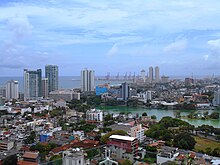

The government initiatives in development of tourism date back to 1937 when the Ceylon Tourist Bureau was established.[11] However, it was closed down in September 1939 due to World War II. After Sri Lanka's independence the promotion of tourism was again considered by re-establishing the Ceylon Tourist Board which took over the function of the Tourist Bureau. More formal recognition for the country's tourism sector was given with the enactment of Act No. 10 of 1966.[12] This provided the legislation for the establishment of Ceylon Tourist Board. Since then the Ceylon Tourist Board has functioned as the state agency, responsible for development and promotion of the tourism sector in Sri Lanka.
In October 2007 according to Section 2 of the Tourism Act No. 38 of 2005, the Sri Lanka Tourist Board (Act No 10 of 1966) was replaced by the Sri Lanka Tourism Development Authority (SLTDA).[13]
Currently Sri Lanka Tourism Development Authority has classified Sri Lanka into several resort regions suitable for tourism development.[14]
- Colombo and Greater Colombo Resort Region: The Colombo and Greater Colombo Resort Region spreads along the Mount Lavinia in the south to Negambo in the north. Colombo city is the main part of the zone, and is the center for business activities, conferences and sport events in the country. Colombo serves as both a gateway and stopover point for international tourists.
- South Coast Resort Region: The south coast zone extends from Wadduwa to Tissamaharama. The zone has been divided into two main regions. The first region extends from Wadduwa to Galle. Coastal areas like Kalutara, Beruwala, Bentota, Dedduwa, Madu Ganga, Balapitiya, Ahungalla, and Hikkaduwa are included in this region. The second region, extending from Galle to Tissamaharama, includes Unawatuna, Koggala, Weligama, Mirissa, Matara, Tangalle and Hambantota areas as sub-points of the zone.
- East Coast Resort Region: The East Coast Resort Region extends from Kuchchaveli in the north to Pottuvil in the south. The main tourism zones in this region are Arugam Bay, Pasikudah, Trincomalee and Nilaveli.
- West Coast Resort Region: The West Coast Resort Region extends along Kalpitiya, Marawila and Waikkala areas.
- High Country Resort Region: Nuwara Eliya, Bandarawela and Maskeliya are included for the High Country Resort Region.
- Ancient Cities Resort Region: This region has five world heritage sites, namely Anuradhapura, Dambulla, Kandy, Polonnaruwa and Sigiriya. Other regions include Habarana, Giritale, Matale and Victoria.
- Other Resort Regions: This includes Yala, Udawalawa, Wasgamuwa, Pinnawala, and Ratnapura area.
Visa/Entry Requirements
[edit]Tourism visitors to Sri Lanka must obtain an Electronic Travel Authorization (ETA). They are not hard to get, and last for a period of 30 days once you enter the country. For information on specific countries, visit Visa Policy of Sri Lanka.[15]
Currency/Conversion
[edit]Current (2018) currency conversion rates for 1 Sri Lankan Rupee:
- .0064 USD
- .0081 CAD
- .0052 EURO
- .69 JPY
- .0045 GBP
Tourism Niche Markets
[edit]The majority (80-85%) of tourists arriving in Sri Lanka do so for pleasure or holiday. Of those that come, most spend time on the coast, eating food and enjoying the pristine beaches and surfing spots, while the rest enjoy heritage tourism and agricultural tourism. In recent years, however, Sri Lanka has dedicated many resources to the development of Medical/Health tourism. [16]
Accommodations/Infrastructure
[edit]
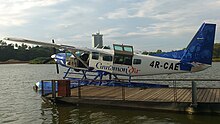
Tourist accommodations in Sri Lanka consist of graded hotels, supplementary establishments, guest houses and limited scale camping sites. More informal accommodation is available on a paying guest system in private houses and hill-country tea estate bungalows.
Tourism infrastructure is essentially non-existent in many parts of Sri Lanka. Civil unrest and a 30 year war ending in 2009 made development of tourism almost impossible. However in recent years the Sri Lankan government has made extensive plans to expand tourism infrastructure.[17][18]
Transportation
[edit]There are many ways to get around Sri Lanka, most of which are relatively cheap. There is an extensive railway system on the island, as well as hundreds of bus routes. However, busses and trains are reported to be quite crowed and uncomfortable.
Another way of seeing Sri Lanka at your own pace is to rent a Tuk Tuk (small three-wheeler) or a car. Tuk Tuk rentals are not hard to find, and you can often deal directly with the owners for a good price. Car rentals are more expensive, but provide a good amount of autonomy on your trip.[19]
Tourism Statistics
[edit]When the government decided to develop the tourism sector as a separate sector of the country's economy by establishing the Ceylon Tourist Bureau in 1966, there were 18,969 foreign tourist arrivals in Sri Lanka. There was an upward trend of tourist arrivals until 1982, with the exception of 1971. Between 1976 and 1982, tourist arrivals had increased 24% per year. The tourist traffic in 1982 showed that there was a remarkable growth in number of tourists, with 407,230 arrivals.[20] However, with the beginning of the civil war in 1983, the growth of tourist arrivals declined and stagnated to around 300,000 - 500,000 arrivals annually.
The civil war that had lasted over 25 years was ended in 2009 as LTTE separatists were defeated by government forces. In 2009 the tourist arrivals numbered 448,000, and in 2015, 1,798,380, showing over 300 percent growth in six years.[21]
| Rank | Country | 2016 | 2017 |
|---|---|---|---|
| 1 | 356,729 | 384,628 | |
| 2 | 271,577 | 268,952 | |
| 3 | 201,879 | 188,159 | |
| 4 | 130,227 | 133,275 | |
| 5 | 96,440 | 97,282 | |
| 6 | 74,496 | 81,281 | |
| 7 | 95,167 | 79,371 | |
| 8 | 58,176 | 59,191 | |
| 9 | 54,254 | 57,479 | |
| 10 | 41,373 | 51,148 | |
| Total foreign | 2,050,832 | 2,116,407 |

Tourism Attractions
[edit]Tourist attractions are classifiable as natural or anthropogenic. Natural attractions include nature spots, flora and fauna, and places with a pleasant climate. Geotourism sites may also be included in this category. Anthropogenic attractions include archaeological and cultural attractions, historical and religion sites, performing arts and folklore, handicrafts and artifacts.
Wildlife
[edit]Despite its small size, Sri Lanka possess high level of biodiversity and wildlife resources, and is rated among the 34 biodiversity hotspots in the world.[29] Many species of flora and fauna are indigenous to Sri Lanka. This has made the island a country with the highest rates of biological endemism in the world.
13% of Sri Lanka's land surface has been designated as Wildlife Protected Areas (WLPAs) which at present exceeds a total area of 8500 km2.[30] Approximately 7% of the area is national parks, the areas allowed for the public to see and study wildlife. Sri Lanka's national parks have been become popular tourist destinations.
| National parks
Adam’s Bridge · Angammedilla · Bundala · Chundikkulam · Delft · Flood Plains · Gal Oya · Galway's Land · Hikkaduwa · Horagolla · Horton Plains · Kaudulla · Kumana · Lahugala Kitulana · Lunugamvehera · Madhu Road · Maduru Oya · Minneriya · Pigeon Island · Somawathiya · Udawalawe · Ussangoda · Wasgamuwa · Wilpattu · Yala |
Beaches
[edit]
Sri Lanka possesses nearly 1600 km coastlines with tropical beaches which are popular among both local and foreign tourists.[33] Most of the coastlines of the country are studded with varying coastal features such as bays, lagoons, sandbanks, and rocky headlands. Marine recreation activities, such as sea bathing and swimming, surfing, boating, snorkelling, deep-sea fishing, underwater photography, and scuba diving, can be seen at most of these beaches and related resort areas. Beaches at Tangalle, Beruwala, Mirissa, Bentota, Unawatuna Arugam Bay, Pasikudah, Hikkaduwa, Uppuveli and Negombo are considered as famous tourist beaches in the country.
| Related attractions
Hummanaya · Stilt fishing |
Natural scenic beauty
[edit]Sri Lanka has numerous tourist attractions with areas of natural scenic beauty, primarily including mountainous terrains, agricultural landscapes, waterfalls, places with diverse climatic conditions, reservoirs (wewas), and rivers.
| Related attractions
Waterfalls of Sri Lanka · Mountains of Sri Lanka · Rivers of Sri Lanka |
Botanical/zoological gardens
[edit]
The country has six botanical gardens and four Zoological gardens. The botanical gardens are maintained by the Department of National Botanical Gardens,[34] and the zoological gardens are maintained by the Department of National Zoological Gardens.[35] The gardens have become attractive places among local and foreign visitors.
| Botanical Gardens
Royal Botanical Gardens · Hakgala Botanical Garden · Henarathgoda Botanical Garden · Mirijjawila Botanical Garden · Seetawaka Botanical Garden · Ganewatta Forest Medicinal Herbal Botanical Garden |
| Zoological Gardens
National Zoological Gardens · Pinnawala Elephant Orphanage · Pinnawala Open Zoo · Ridiyagama Safari Park |
Heritage
[edit]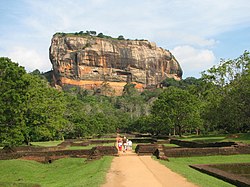
Heritage tourism involves visiting historical sites. Sri Lanka is very rich in pre-historic, proto-historic, and historic monuments, which bespeak its ancient civilization and culture. Mainly Buddhism has influenced in moulding the cultural heritage of the country. The historic period of Sri Lanka proper starts at circa 236 B.C. with the introduction of Buddhism to the country by the missionaries sent by the Indian empire Asoka.
The UNESCO has declared six archaeological and two ecological World Heritage Sites in the country.[37] Beside the world heritage sites the government of Sri Lanka has declared a number of archaeological protected sites and monuments within the country.
| World Heritage Sites
Anuradhapura · Central Highlands of Sri Lanka · Dambulla cave temple · Galle · Polonnaruwa · Sigiriya · Sinharaja Forest Reserve · Temple of the Tooth |
Pilgrimage
[edit]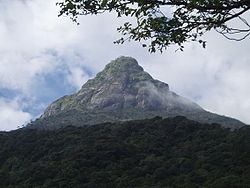
Sri Lanka is well known for its rich Buddhist culture as well as other religions. Being a religious country, Sri Lanka has many places with religious and historic significance, which attract tourists from all over the world. Anuradhapura, Temple of the Tooth, Sri Pada, Shrine of Our Lady of Madhu and Kataragama, are a few famous religious sites in the island that attract a large number of tourists[39].
The foot pilgrimage called Pada Yatra, which is one of Sri Lanka's oldest traditions, has been practiced for centuries, where the local people from Jaffna come along the East Coast to Kataragama shrine.[40]
| Related attractions
Buddhist Vihara in Sri Lanka · Hindu temples in Sri Lanka · Atamasthana · Solosmasthana |
Sports and adventure
[edit]Sports tourism is defined as either people being involved in, observing or participating in a particular sporting event for leisure.[41] Sri Lanka is also a destination for sports such as cricket, rugby, golf and surfing. Except for cricket, the contribution to the tourism sector from other sports are still at a very low level. Apart from mainstream sports events, adventure sports are also included in sports tourism. Trekking, hiking, diving, rock climbing, deep sea fishing, whale watching and hot air ballooning are some of the adventure sports those can be found in Sri Lanka.[42]
| Related attractions
Whale watching in Sri Lanka |
Culture and other
[edit]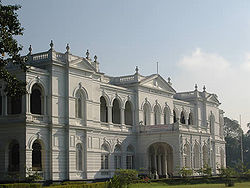

Cultural tourism includes tourism in urban areas, particularly historic or large cities and their cultural facilities such as museums and theatres.
Museums and theatres - Currently four national museums[44] and 26 archaeological museums[45] have been established in Sri Lanka. National museums are maintained by the Department of National Museums and archaeological museums by the Department of Archaeology. Beside the museums a large number of theatres also can be found in Sri Lanka.
Festivals - Sri Lanka is a multi-cultural country with several different festivals celebrated by various communities. Sinhala and Tamil New Year celebrations, Vesak Festival, Christmas, Ramadan festival, Thai Pongal, and the Galle Literary Festival are a few of the major festivals.
Performing arts - There are three main traditional dance forms in Sri Lanka: Kandyan dancing, low country dancing, and Sabaragamuwa dancing. Though not unique to Sri Lanka, 'Bharatanatyam', which originated from India is also popular in Sri Lanka particularly among the Tamil community.
Food - The cuisine of Sri Lanka has been influenced by many historical, cultural, and other factors. Rice is the main staple diet of the country. Other staples include hoppers, string hoppers, and pittu[46].
Being one of the largest producers of tea in the world Sri Lanka is best known for the production of unorthodox tea. Tea was introduced to the country by the British who called the country "Ceylon". Pure Ceylon tea is considered some of the finest tea produced anywhere in the world.
Handicrafts - Handicrafts available in Sri Lanka include wood carving, silverware, brass castings, ceramic ware, bamboo products, pottery, batiks, lace works, cane works, costume jewelry, lacquerware, wooden masks, coir goods, handlooms, and ivory products.
| Related attractions
Museums in Sri Lanka · Theatre of Sri Lanka · Festivals in Sri Lanka · Esala Perahera · Dances of Sri Lanka · Sri Lankan cuisine · Sri Lankan sweets and desserts |
Domestic tourism
[edit]There is a significant domestic tourist segment making excursions in Sri Lanka. In 2014 six million Sri Lankans traveled within the country as domestic tourists.[47] The main purposes of travel by the domestic tourists are pilgrimage, family holiday, study works, and sightseeing. The main destinations of domestic tourists are Anuradhapura, Kataragama, Nuwara Eliya, Kandy, Sri Pada, Polonnaruwa, Sigiriya and Dambulla. Domestic tourism is noticeable during school vacations and on weekends.
Tourism Earnings
[edit]The tourist industry makes a significant contribution to the national economy by directly contributing to the government budget, foreign-exchange earnings and employment generation. It contributes both directly and indirectly, in the provision of goods and services to the tourist sector.
Safety
[edit]Sri Lanka, despite having just finished a 30 year civil war, is considered a very safe place to travel, with violence against foreigners being virtually unheard of on the island. There still exists some unrest between Muslim and Buddhist communities, but the risk assessment threat remains at a level 1 (normal safety precautions).[48][49]
Social and Environmental Impacts
[edit]Tourism in Sri Lanka, despite its benefits for the local economy (it is one of the main foreign income sources of the country), has its critics. Some studies indicate that quick modern tourism development would not cater to the specific needs of the local people.[50] Also, the high biodiversity of Sri Lanka seems to be threatened by the development of mass tourism which has already affected several natural reserves. Some endangered animal species seem to be seriously threatened by the rise of tourism in some areas; that is the case with the Keerthisinghe’s Rock Frog, which is endemic in Sri Lanka.[51]
An alternative kind of tourism, called ecotourism, sustainable tourism or responsible tourism, enables travelers to participate in tourism throughout Sri Lanka while contributing on the well-being of the local communities and making sure their environmental impact is limited.[52] The Sri Lanka Ecotourism Foundation is the national organization that created an official ecotourism network through the island, allowing to develop sustainable tourism with wide options of travel. In 2010, the foundation won the presidential awards for "Outstanding Contribution for Tourism in Sri Lanka".[53]
Emergency Contacts
[edit]| Emergency Services | Telephone Number |
| Police Emergency Hotline | 118 / 119 |
| Ambulance / Fire & rescue | 110 |
| Accident Service-General Hospital-Colombo | 011-2691111 |
| Tourist Police | 011-2421052 |
| Police Emergency | 011-2433333 |
| Government Information Center | 1919 |
| Report Crimes | 011-2691500 |
| Emergency Police Mobile Squad | 011-5717171 |
| Fire & Ambulance Service | 011-2422222 |
See also
[edit]- Economy of Sri Lanka
- Travel and Tourism Competitiveness Report
- Visa policy of Sri Lanka
- World Tourism Organization
- World Travel Monitor
- ^ "Where is Sri Lanka?". WorldAtlas. Retrieved 2018-04-12.
- ^ "Climate in Sri Lanka". lanka.com. Retrieved 2018-04-12.
- ^ (http://www.hydrant.co.uk), Site designed and built by Hydrant. "Sri Lanka : History | The Commonwealth". thecommonwealth.org. Retrieved 2018-04-13.
- ^ "Sri Lanka Population (2018) - Worldometers". www.worldometers.info. Retrieved 2018-04-13.
- ^ (http://www.hydrant.co.uk), Site designed and built by Hydrant. "Sri Lanka : Constitution and politics | The Commonwealth". thecommonwealth.org. Retrieved 2018-04-13.
- ^ "What Languages Are Spoken In Sri Lanka?". WorldAtlas. Retrieved 2018-04-13.
- ^ "Religious Beliefs In Sri Lanka". WorldAtlas. Retrieved 2018-04-13.
- ^ "Sri Lankan Food: 40 of the Island's Best Dishes". Migrationology - Food Travel Blog. 2011-11-15. Retrieved 2018-04-13.
- ^ "Sri Lanka - Language, Culture, Customs and Etiquette". www.commisceo-global.com. Retrieved 2018-04-13.
- ^ "10 most popular cities for travelers in 2015". CNN. Retrieved 6 November 2016.
- ^ "Overview". Sri Lanka Tourism Development Authority. Retrieved 9 November 2016.
- ^ "History at SLTDA". Sri Lanka Tourism Development Authority. Retrieved 5 November 2016.
- ^ "Sri Lanka Tourism Development Authority". Sri Lanka Tourism Development Authority. Retrieved 5 November 2016.
- ^ "Key Development Projects". Sri Lanka Tourism Development Authority. Retrieved 6 November 2016.
- ^ "Entry requirements - Sri Lanka travel advice - GOV.UK". www.gov.uk. Retrieved 2018-04-13.
- ^ "Top 10 tourist source markets and marketing of Sri Lanka tourism niches | FT Online". www.ft.lk. Retrieved 2018-04-13.
- ^ "Countrywide tourism infrastructure development drive gets underway". www.sundaytimes.lk. Retrieved 2018-04-13.
- ^ "Sri Lanka - Infrastructure | export.gov". www.export.gov. Retrieved 2018-04-13.
- ^ "Getting around | About Sri Lanka". Rough Guides. Retrieved 2018-04-13.
- ^ "Overview of Tourism Industry In Sri Lanka". Sri Lanka Tourism Development Authority. Retrieved 9 November 2016.
- ^ "Post-civil war, Sri Lanka's tourism industry having one great run". The Hindu. 30 April 2016. Retrieved 9 November 2016.
- ^ TOURIST ARRIVALS BY COUNTRY OF RESIDENCE 2016
- ^ Tourist Arrivals by Region - December 2016 & December 2017
- ^ Including Hong Kong and Macau.
- ^ "Yala's giant leopards". BBC. 13 October 2014. Retrieved 12 November 2016.
- ^ "Minneriya National Park". www.yamu.lk. Retrieved 12 November 2016.
- ^ "The Gathering: Sri Lanka's great elephant migration". CNN. 3 October 2014. Retrieved 12 November 2016.
- ^ "'Spectacular' coverage for The Gathering". The Sunday Times (Sri Lanka). 17 July 2011. Retrieved 12 November 2016.
- ^ "Wildlife tourism in Sri Lanka". www.ft.lk. 12 September 2012. Retrieved 12 November 2016.
- ^ "Overview". Department of Wildlife Conservation. Retrieved 12 November 2016.
- ^ "Could Unawatuna enter the record books as the World's Best Beach once again?". www.news.lk. Retrieved 12 November 2016.
- ^ "World's 100 best beaches#Unawatuna, Sri Lanka". CNN. 28 May 2013. Retrieved 12 November 2016.
- ^ "Pristine". www.srilanka.travel. Retrieved 12 November 2016.
- ^ "Department of National Botanical Gardens". Ministry of sustainable development and wildlife. Retrieved 12 November 2016.
- ^ "Department of National Zoological Gardens". Government Information Center. Retrieved 12 November 2016.
- ^ "Eighth wonder of the world ?". www.news.lk. 17 January 1999. Retrieved 13 November 2016.
- ^ "Cultural Heritage". www.srilanka.travel. Retrieved 13 November 2016.
- ^ "Sri Pada Mountain (Adams Peak) – ශ්රී පාදය (සමනල කන්ද)". Amazing Lanka. Retrieved 13 November 2016.
- ^ http://srilankabudhisttours.com/
- ^ "Pilgrimage". www.srilanka.travel. Retrieved 13 November 2016.
- ^ "Sports Tourism is worth $600 billion and Sri Lanka enters with Golf and Surfing". www.news.lk. 18 August 2015. Retrieved 13 November 2016.
- ^ "Adventure Sports". www.srilanka.travel. Retrieved 13 November 2016.
- ^ "Promoting tea tourism". Sunday Observer (Sri Lanka). 26 September 2010. Retrieved 14 November 2016.
- ^ "Department of National Museums". Department of National Museums. Retrieved 14 November 2016.
- ^ "Museums". Department of Archaeology. Retrieved 14 November 2016.
- ^ http://www.strong.lk/2016/02/18/good-food-habits-for-sri-lankans/
- ^ "Six million tourists travel within Sri Lanka". The Sunday Times. 14 December 2014. Retrieved 9 November 2016.
- ^ Sachs, Andrea (2018-03-10). "Sri Lanka issues a state of emergency, but most of the country is safe for visitors". Washington Post. ISSN 0190-8286. Retrieved 2018-04-13.
- ^ "Sri Lanka travel advice - GOV.UK". www.gov.uk. Retrieved 2018-04-13.
- ^ Evan Due (1980). "Tourism and Development: Examining the Case of Sri Lanka". Open Access Dissertations and Theses.
- ^ Gazala Anver. "Tourism Threatening Endangered Species". The Sunday Leader.
- ^ J. Thumira Gunasena. "Tourism in Sri Lanka and its Impact on Social Political and Natural Environment" (PDF).
{{cite journal}}: Cite journal requires|journal=(help) - ^ "SRI LANKA ECOTOURISM FOUNDATION".
- ^ "LIST.LK - Emergency Telephone Numbers in Sri Lanka". www.list.lk. Retrieved 2018-04-13.


